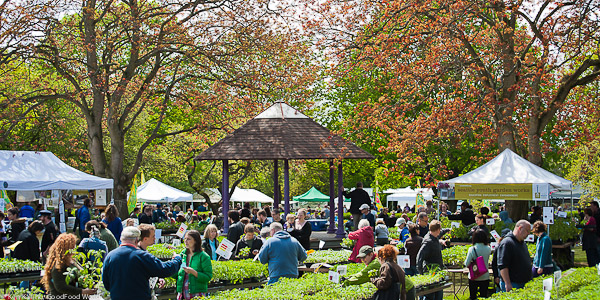It’s been a cool, late spring here in Puget Sound, which means there’s still time to plant a garden. In fact, we’ve just gotten the tomatoes we bought at the Seattle Tilth Edible Plant Sale in the ground!
Seattle Tilth, a well-known local non-profit dedicated to inspiring and educating people to garden organically, holds very successful plant sales every year as part of their fund-raising efforts. In 2010, Tilth sold nearly 80,000 edible plants at their sales and at the 2011 spring sale, more than 6,000 participants purchased almost 56,000 organic plant starts.
 (Take a virtual tour of the Seattle Tilth Edible Plant Sale here.)
(Take a virtual tour of the Seattle Tilth Edible Plant Sale here.)
It takes organizations like Tilth to bring organic gardening into focus by teaching families to garden in Puget Sound. More than 10,000 children and adults participated in Tilth-sponsored classes and garden programs in 2010. And it takes successful sales to generate the revenue needed to develop those educational programs.
Unfortunately, the need for revenue from plant sales also means that the plants sold at those sales may be beyond the means of some gardeners in the city. Add together the cost of the plant starts, the compost needed to fertilize them, and the water to keep them growing and you’ve priced the vegetables out of reach of households with less discretionary income.
Where to get plants and seeds?
Buying starts and seeds from local growers and at local sales ensures that you get plants that are climate-appropriate. There are some plants that just don’t do well in our short summers!
For households on tight budgets, who can’t afford to buy plant starts, sharing purchased or saved seeds brings down the cost of garden plants. Even a few seeds in a container on a deck or balcony can add fresh produce to a family’s diet.
Why garden?
Gardening not only provides a connection with nature, it connects us to our food. As more and more people are concerned about the provenance of their food – where it came from and how it was grown – gardening has given “local” a new meaning: “Zero Food Miles.”
During both World Wars, families in the U.S. and Europe planted Victory Gardens; it was a time when everyone gardened. During World War I, as many as 5 million gardens were planted and during World War II the number grew to 20 million. In 2008, according to the National Gardening Association, 36 million households grew vegetables, fruits, berries and/or herbs in family or community gardens and 43 million had plans to garden in 2009.
Today, we garden not out of patriotic duty, but to put food on our tables. The 2010 Summer Gardening Trends Research Report conducted for the Garden Writers Association Foundation discovered that:
- 58% want better tasting food
- 54% want to save money on food bills
- 51% want better quality food
- 48% want to grow food they know is safe
What do gardeners grow? What do they do with it?
Another survey, this one by the National Gardening Association, looked at the main reasons that people grow gardens:
- 90% plan to eat the produce fresh
- 66% will share with friends
- 36% will can or preserve their produce
- 24% will donate food to others
Local food production will ensure access to good food as the cost of transportation goes up and imported food becomes more and more expensive. Food security begins at home – literally.
Get out your trowel, get your hands dirty, and plant a garden, a plot, or a pot!
